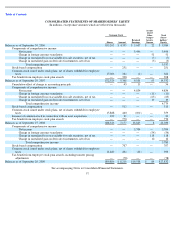Apple 2009 Annual Report Download - page 63
Download and view the complete annual report
Please find page 63 of the 2009 Apple annual report below. You can navigate through the pages in the report by either clicking on the pages listed below, or by using the keyword search tool below to find specific information within the annual report.
Table of Contents
the time of purchase and reevaluates the available-for-
sale designations as of each balance sheet date. The Company classifies its marketable
debt securities as either short-term or long-term based on each instrument’
s underlying contractual maturity date. Marketable securities with
maturities of less than 12 months are classified as short-
term and marketable securities with maturities greater than 12 months are classified as
long-term. These securities are carried at fair value, with the unrealized gains and losses, net of taxes, reported as a component of shareholders’
equity. The cost of securities sold is based upon the specific identification method.
Derivative Financial Instruments
During the second quarter of 2009, the Company adopted FASB ASC 815, Derivatives and Hedging
(formerly referenced as SFAS No. 161,
Disclosures about Derivative Instruments and Hedging Activities
– an amendment of FASB Statement No. 133
), which requires additional
disclosures about the Company’
s objectives and strategies for using derivative instruments, how the derivative instruments and related hedged
items are accounted for, and how the derivative instruments and related hedged item affect the financial statements.
The Company accounts for its derivative instruments as either assets or liabilities and carries them at fair value. Derivatives that are not defined
as hedges must be adjusted to fair value through earnings.
For derivative instruments that hedge the exposure to variability in expected future cash flows that are designated as cash flow hedges, the
effective portion of the gain or loss on the derivative instrument is reported as a component of accumulated other comprehensive income in
shareholders’
equity and reclassified into earnings in the same period or periods during which the hedged transaction affects earnings. The
ineffective portion of the gain or loss on the derivative instrument is recognized in current earnings. To receive hedge accounting treatment, cash
flow hedges must be highly effective in offsetting changes to expected future cash flows on hedged transactions. For options designated as cash
flow hedges, changes in the time value are excluded from the assessment of hedge effectiveness and are recognized in earnings. For derivative
instruments that hedge the exposure to changes in the fair value of an asset or a liability and that are designated as fair value hedges, the net gain
or loss on the derivative instrument as well as the offsetting gain or loss on the hedged item attributable to the hedged risk are recognized in
earnings in the current period. The Company did not have a net gain or loss on these derivative instruments during 2009, 2008 and 2007. The net
gain or loss on the effective portion of a derivative instrument that is designated as an economic hedge of the foreign currency translation
exposure of the net investment in a foreign operation is reported in the same manner as a foreign currency translation adjustment. For forward
exchange contracts designated as net investment hedges, the Company excludes changes in fair value relating to changes in the forward carry
component from its definition of effectiveness. Accordingly, any gains or losses related to this component are recognized in current earnings.
Fair Value Measurements
During the first quarter of 2009, the Company adopted FASB ASC 820, Fair Value Measurements and Disclosures
(formerly referenced as
SFAS No. 157, Fair Value Measurements
), which defines fair value, establishes guidelines for measuring fair value and expands disclosures
regarding fair value measurements. This new accounting standard does not require any new fair value measurements. The Company applies fair
value accounting for all financial assets and liabilities and non-
financial assets and liabilities that are recognized or disclosed at fair value in the
financial statements on a recurring basis. The Company defines fair value as the price that would be received from selling an asset or paid to
transfer a liability in an orderly transaction between market participants at the measurement date. When determining the fair value measurements
for assets and liabilities, which are required to be recorded at fair value, the Company considers the principal or most advantageous market in
which the Company would transact and the market-
based risk measurements or assumptions that market participants would use in pricing the
asset or liability, such as inherent risk, transfer restrictions and credit risk.
During the first quarter of 2009, the Company adopted FASB ASC 825, Financial Instruments (formerly referenced as SFAS No. 159,
The Fair
Value Option for Financial Assets and Financial Liabilities – Including
60
























